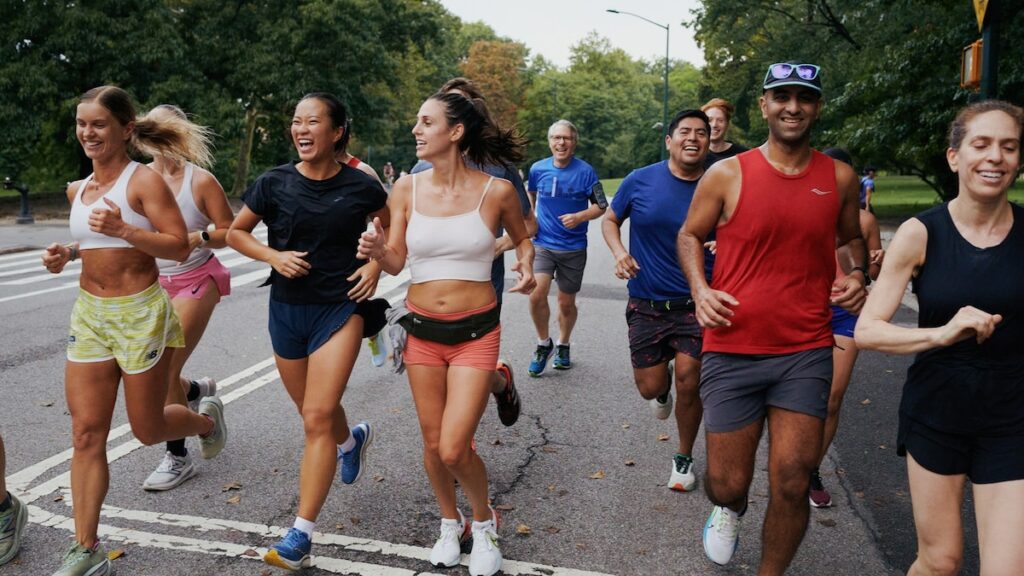Before joining Washington D.C.-based District Running Collective, Fallon Jones wasn’t a runner. “An old friend—we were doing CrossFit at the time—she said that there’s this group of Black people that run up the street,” she says. She was hooked after her first run with the group the following week.
“The energy was so electric. I am in the slower pace group, but everybody was there at the end to cheer me on,” says Jones. “I thought, you know what? If I keep coming back, maybe I can get a little better.”
Run clubs have a long history dating back to the early 19th century. The first known running club, the Thames Hare and Hounds, was established in 1868 in London, promoting the sport as a social activity. Over the decades, running clubs spread across Europe and North America, initially attracting competitive runners but gradually appealing to a broader audience seeking support, motivation, and camaraderie.
In recent years, the rise of social media and fitness apps has further transformed run clubs. Online platforms allow runners to connect, organize events, and track progress, making running more accessible and inclusive.
Joining a run club not only fosters new friendships, it also enhances mental well-being. Additionally, maintaining a conversational pace while running with friends can offer distinctive physical benefits, too.
The science behind conversational running
Conversational running refers to maintaining a pace at which you can comfortably speak in complete sentences as you move. It is often associated with Zone 2 training, which involves an intensity of 60 to 70 percent of your maximum heart rate.
Kristen Hislop, a certified running and triathlon coach, says that people often struggle to achieve this pace because it doesn’t feel like a “hard” workout; it’s often much slower than you’d anticipate. But even though it doesn’t feel especially challenging, low to moderate-intensity training is great for your overall health, she says.
(Does the perfect workout really exist?)
“Doing low-intensity exercise on a regular basis is going to build endurance so you’ll be able to go longer and further,” says Hislop. “You’re also going to recover faster and reduce your risk of injuries.” And, compared to high-intensity exercises, which use sugar as fuel, low-intensity exercise burns fat more effectively.
The social benefits of running with others
But running isn’t only good for your body; it’s also good for your relationships.
Rachel Goldberg, a licensed marriage and family therapist who incorporates walk-and-talk sessions into her practice, has noticed that people are much more willing to open up during exercise.
“If you are near somebody but not necessarily facing them eye to eye, there might be a little bit more willingness to open up or you might just feel a little bit less intimidated,” she says. This vulnerability can lead to deeper conversations and stronger connections. She adds that this is also a phenomenal way to break social anxiety barriers.
(Do you really need 10,000 steps a day? Here’s what the science says.)
One reason may be that running stimulates endorphins, the body’s natural feel-good chemicals. “When you have endorphins released, you feel better, you feel less stress, everything around you starts to seem more positive,” says Goldberg. “In terms of relationships, that leads to feeling more positive association to the person that you’re with, which helps create more bonding.”
Conversational running can also enhance cognitive function by increasing blood flow to the brain, improving mental clarity, and reducing stress levels.
Building community through running
Running with others can be a great way to ensure you’re keeping a conversational pace and forming a community at the same time. Danielle Burnett, leader of Big Girls Who Run in Long Beach, California, recently hosted her first group run: “At the start, people were chatting a bit, but not super crazy,” she says. “Then, when we came back [from the run], it felt like connections had been made. People were already talking about meeting up for runs later that week.”
Burnett also understands the anxiety that can accompany exercising in public. “When I started getting into running, it was more of a solo thing for me. I really wanted the community aspect, but I felt overwhelmed,” she says. “I didn’t see many run clubs that matched my pace.”
Finding the right run club to fit your needs is crucial. Jones knew her club was the right fit after her first outing. “They did a really good job of explaining the different pace groups.”
Since then, she has made lifelong friends. “As someone who is approaching 40, it has been a blessing to find friends of all ages at this stage in life,” she says. “These are people I might not have known outside of showing up on Wednesdays. But these are people I have dinner with, and I would go on vacation with. It’s been beautiful to be a part of this running community.”
>>> Read full article>>>
Copyright for syndicated content belongs to the linked Source : National Geographic – https://www.nationalgeographic.com/science/article/benefits-of-social-running
